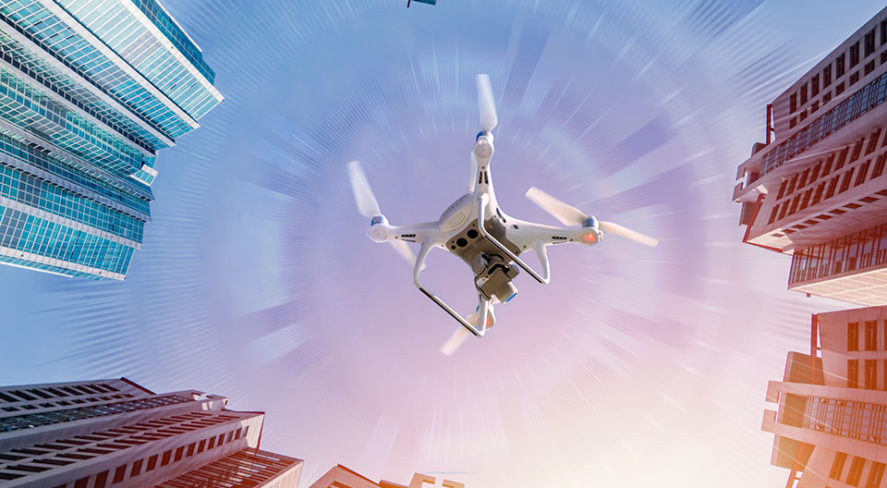Guest Opinion: Why It’s Time to Get Serious About the Risk of Commercial Drones

Building Intelligence President Bill Edwards says federal policy regulating commercial drone technology is better late than never but far too shortsighted.

There is no argument against the fact that we are experiencing the “Wild West” with the evolution of commercial drone technology. I recently read that the commander of the United States Special Operations Command stated in all his time on the battlefield he never had to “look up, “ a reference to the United States’ assumption of air superiority since the Korean War. Times have changed. It’s now six months into the war in Ukraine, and we have gained a tremendous amount of information about the evolution and now the convergence of commercial drones and military drones in conflict. More importantly, drone technology and its use should prompt us to ask what we can draw from this expansion and what the effects are on domestic security and safety in society.
- Since its 2010 inception, the commercial drone market is estimated to grow to an $11 billion enterprise by 2031. Why is this important? This figure indicates potential growth and the need/want demonstrated by society to expand production and use. Commercial drones are here to stay, and momentum is strong.
- Estimates have shown over 6,000 drones are in play in Ukraine, including technology from many different countries. Ukraine is providing laboratory and experimentation space for drone makers and creating precipitous technical growth and use case testing. All of this is open to the public via social media. Ukraine is dominating the information campaign on all fronts.
- The Ukraine war has openly shown the creativity and innovation associated with commercial-off-the-shelf drone use. The first-person view capability is a great example.
- Comprehensive security program development continues to lag when it comes to drone threat assessments and risk mitigation action.
- Public space is more vulnerable to a myriad of threats posed by commercial drones. Venues that support large public gatherings tend to be unprepared for a drone event and have even less authority to do something proactive.
- Areas that need consideration are drone detection and monitoring, counter-unmanned aerial system tools (public and private sector), unmanned traffic management and urban air mobility.
In March 2021, the Federal Aviation Administration (FAA) issued a new rule for the commercial drone market requiring “digital license plates” by September 2023. This move is positive, but there are many reasons why it still falls short of what our aviation governing body of the nation needs to do, not to mention that the ruling gave drone companies and private owners over two years to implement. Two questions concerning this ruling are 1) why it took so long and 2) why it was pushed out two years from the decision. As drones continue to develop, it is clear we need to get away from “baby steps” and start taking “giant steps forward” to support the continued assimilation of this technology into everyday society and prepare for instances that may be nefarious use.
Over a year later, the current administration published a national action plan this April concerning domestic counter-unmanned aircraft systems (CUAS). The plan provides eight key recommendations. Although a good start and follow-up to the FAA’s “digital license plate” ruling, this action plan falls well short of what is needed with this technology and the pace at which it is evolving. It seems that lawmakers are trailing behind what is taking shape, and the Ukraine conflict has only made things worse by accelerating proven use cases in the conflict zone. Additionally, although the action plan addresses state, local, territorial and tribal entities, it is an action plan written for government organizations and agencies at various levels of government.
So, what about the private sector and venues that host large public events?
Additionally, in a recent letter to Congress, the U.S. Chamber of Commerce Technology Engagement Center encouraged “Congress to move expeditiously” to advance the eight pillars of the national action plan. Again, this is another positive step that shows people are taking notes, but we are moving too slowly. The letter continues to address federal interest while leaving out the nature of public business and the impact a drone event could have on the nation if private businesses are not allowed to be proactive and take the necessary action to honor their “duty of care” responsibility. The national action plan needs to energize all elements of the public-private partnership to provide a comprehensive approach concerning commercial drone technology. They simply continue to leave out options or don’t want to address how to protect large public gatherings in the private sector. The majority of, if not all, large public gatherings are provided by private organizations, including major sports events, concerts and festivals, which are our most vulnerable population.
In essence, these actions still leave us with many unanswered areas of concern and show there is work needed to holistically address the need. What can and should the federal government do? The answer is simple: lead. This is a technology like what we’ve faced over the past decade concerning cybersecurity threats. That threat, not unlike the emergence of a robust commercial drone market, requires a “whole of government” approach that includes a strong public-private partnership. We’ve seen this take shape with great results through education, prevention and action. The drone market requires the same level of diligence. There is no doubt that the drone superhighway will be a reality below 400 feet above ground level in the next five years. Look no further than major service providers like Amazon as they prepare for drone deliveries. As the article notes, we are not too far off from that reality. Additionally, business owners who do host the public are in a high-risk environment, while insurance companies wrestle with the appropriate level and terms for coverage. Simply stated, if the problem continues to grow, it may force business owners to rethink large public events.
Lastly, in all three instances of interest/action concerning this technology, there is no mention of addressing unmanned traffic management and urban air mobility. The public and business interest in commercial drones and their impact on society are gaining momentum, but we are moving far too slowly and way behind the evolution of the technology. We can’t wait for a “bad day” to occur before we get serious about a comprehensive approach to technology. CUAS is only one narrowly defined action item. We can talk all day long at the federal level about CUAS and steps to begin our journey to understanding the capability while protecting people, but we also need to competently address how all this new traffic will and does affect private businesses that host large public events, not to mention the need to manage these platforms in a safe zone outside of commercial air traffic.
The FAA needs to rapidly address the need for an electronic drone exclusion zone capability, and the federal government needs a legislative champion to see this through. It is no longer enough to simply post a rule that drones aren’t allowed; the capability to provide electronic direction and, if necessary, mitigation within a limited bubble needs to be authorized before a drone is used to affect a terrorist attack in the United States. Let’s keep the conversation going!
The views and opinions expressed in guest posts and/or profiles are those of the authors or sources and do not necessarily reflect the official policy or position of the Security Industry Association.
